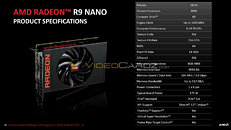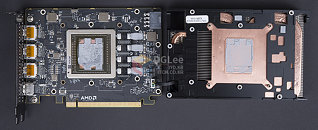- Joined
- Oct 9, 2007
- Messages
- 47,633 (7.44/day)
- Location
- Dublin, Ireland
| System Name | RBMK-1000 |
|---|---|
| Processor | AMD Ryzen 7 5700G |
| Motherboard | Gigabyte B550 AORUS Elite V2 |
| Cooling | DeepCool Gammax L240 V2 |
| Memory | 2x 16GB DDR4-3200 |
| Video Card(s) | Galax RTX 4070 Ti EX |
| Storage | Samsung 990 1TB |
| Display(s) | BenQ 1440p 60 Hz 27-inch |
| Case | Corsair Carbide 100R |
| Audio Device(s) | ASUS SupremeFX S1220A |
| Power Supply | Cooler Master MWE Gold 650W |
| Mouse | ASUS ROG Strix Impact |
| Keyboard | Gamdias Hermes E2 |
| Software | Windows 11 Pro |
AMD's upcoming mini-ITX friendly graphics card, the Radeon R9 Nano, which boasts of a typical board power of just 175W, is not a heavily stripped-down R9 Fury X, as was expected. The card will feature the full complement of GCN compute units physically present on the "Fiji" silicon, and in terms of specifications, is better loaded than even the R9 Fury. Specifications sheet of the R9 Nano leaked to the web, revealing that the card will feature all 4,096 stream processors physically present on the chip, along with 256 TMUs, and 64 ROPs. It will feature 4 GB of memory across the chip's 4096-bit HBM interface.
In terms of clock speeds, the R9 Nano isn't too far behind the R9 Fury X on paper - its core is clocked up to 1000 MHz, with its memory ticking at 500 MHz (512 GB/s). So how does it get down to 175W typical board power, from the 275W of the R9 Fury X? It's theorized that AMD could be using an aggressive power/temperature based clock-speed throttle. The resulting performance is 5-10% higher than the Radeon R9 290X, while never breaching a power target. Korean tech blog DGLee posted pictures of an R9 Nano taken apart. Its PCB is smaller than even that of the R9 Fury X, and makes do with a slimmer 4+2 phase VRM, than the 6+2 phase VRM found on the R9 Fury X.


View at TechPowerUp Main Site
In terms of clock speeds, the R9 Nano isn't too far behind the R9 Fury X on paper - its core is clocked up to 1000 MHz, with its memory ticking at 500 MHz (512 GB/s). So how does it get down to 175W typical board power, from the 275W of the R9 Fury X? It's theorized that AMD could be using an aggressive power/temperature based clock-speed throttle. The resulting performance is 5-10% higher than the Radeon R9 290X, while never breaching a power target. Korean tech blog DGLee posted pictures of an R9 Nano taken apart. Its PCB is smaller than even that of the R9 Fury X, and makes do with a slimmer 4+2 phase VRM, than the 6+2 phase VRM found on the R9 Fury X.


View at TechPowerUp Main Site








 , just like allways when he does his magic
, just like allways when he does his magic

 .
. , so I will upgrade, especially under water and turn up the juice, I have the itch for new hardware
, so I will upgrade, especially under water and turn up the juice, I have the itch for new hardware . I really dont need any new hardware, but the feeling in the right fingertip is becomming close to hit the buy button
. I really dont need any new hardware, but the feeling in the right fingertip is becomming close to hit the buy button
 .
.